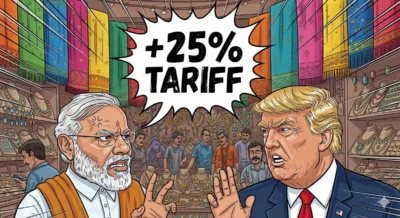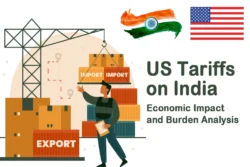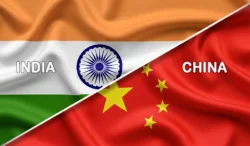
Aug 27, 2025 (UTC) - From today, the United States imposed an additional 25% tariff on most Indian goods, doubling existing duties to 50% for many products. This policy, enacted by President Donald Trump, was a response to India’s purchases of discounted Russian oil amid geopolitical tensions. The tariffs target approximately $48.2 billion of Indian exports to the US, India’s largest trading partner, threatening significant trade disruptions. Economists estimate a 0.4–0.5% reduction in India’s GDP growth for FY26, with widespread impacts on jobs, investment, and labor markets, particularly for micro, small, and medium enterprises (MSMEs).
India’s economy, the world’s fifth-largest, recorded exports of $820.93 billion in FY 2024-25 (April 2024–March 2025), a 5.5% increase from the previous year. This includes $437.42 billion in merchandise and $383.51 billion in services. However, the tariffs jeopardize this growth, especially for merchandise exports to the US, valued at $87.3 billion in 2024. The policy could make Indian goods uncompetitive, contribute to US inflation, and erode India’s trade surplus with America.
Sectoral Impact and FY 2024-25 Export Data
The tariffs impact multiple sectors, with significant consequences for MSMEs, which dominate several export industries. The table below summarizes FY 2024-25 export data, estimated US share, and projected tariff impacts, based on official estimates and extrapolations where necessary.
| Sector | FY 2024-25 Total Exports (USD Billion) | Key Sub-Categories | Estimated US Share | Impact of Tariffs |
|---|---|---|---|---|
| Engineering Goods | 116.67 | Machinery, automobiles, iron & steel | ~20-25% | A 10-15% drop in US exports could disrupt supply chains, with MSMEs in component manufacturing facing order cancellations and reduced revenues. |
| Petroleum Products | ~63.34 (Non-petroleum: 374.08; Total merchandise: 437.42) | Diesel, petrol, aviation fuel | ~15-20% | US exports may fall 20-30%, affecting larger refineries, though MSMEs in ancillary services could face indirect losses. |
| Gems and Jewellery | ~32-35 (Partial up to Feb 2025: 25.73) | Cut & polished diamonds, gold jewellery | A 20-25% decline in US shipments severely impacts MSMEs, with small jewellers and artisans risking closures due to reduced orders. | |
| Pharmaceuticals | 30.47 | Drugs & formulations | ~40% | Margins may shrink by 10-15%, but demand for generics may hold. Small-scale API producers could face competitive pressures from global rivals. |
| Electronics | 38.58 | Components, consumer electronics | ~15-20% | Export growth (up 32.47%) may stall, with tariffs cutting US volumes by 15-20%, hitting MSMEs in component production. |
| Textiles and Apparel | ~36 (Apr-Oct: 21.36) | RMG (15.99), cotton textiles (7.08), man-made (3.11) | ~20-25% | Despite a 35% apparel surge in October, tariffs could cut US exports by 15-20%, devastating MSMEs in weaving and garment clusters. |
| Chemicals | ~30-31 | Organic/inorganic, dyes, agrochemicals | ~15% | US exports may decline by 10-15%, with small chemical manufacturers facing reduced demand for specialty products. |
| Agriculture and Allied (incl. Seafood) | ~48-50 | Rice (12.47), marine products (~8), meat/poultry (5.1) | ~10-15% | A 20% drop in US exports for seafood and rice hits small farmers and MSME processors, compounding existing trade restrictions. |
The US accounts for nearly 20% of India’s merchandise exports. Tariffs could reduce overall US exports by up to 43%, with MSME-heavy sectors like textiles, gems, and agriculture facing the brunt.
Deepened Focus on MSME Impacts
MSMEs, employing over 110 million workers and contributing 45% of India’s exports, are particularly vulnerable to the tariffs due to their reliance on labor-intensive industries and limited financial resilience. These enterprises, often operating on thin margins, face existential risks as US demand contracts.
- Textiles and Apparel: MSMEs account for over 70% of textile exports, concentrated in clusters like Tirupur, Surat, and Panipat. The tariffs could lead to a 15-20% drop in US orders, translating to potential layoffs of 1-2 million workers, many of whom are women in low-wage roles. Small weaving units and garment makers, already grappling with rising cotton prices, may face closures if orders dry up, with a projected 15-25% revenue decline.
- Gems and Jewellery: This sector, where MSMEs contribute 65% of exports, relies heavily on the US market ($11 billion in 2024). The tariffs could trigger a 20-30% revenue drop for small-scale jewellers and artisans in hubs like Jaipur and Surat. Many lack the capital to pivot to new markets, risking business insolvency and job losses for thousands of skilled craftsmen.
- Agriculture and Seafood: Small farmers and MSME processors in coastal states like Andhra Pradesh and Kerala, exporting shrimp and rice, face a 20% export reduction to the US. Combined with existing trade barriers, this could lead to unviable prices, forcing farmers to sell at a loss or abandon export markets. Rural distress may intensify, with ripple effects on local economies.
- Supply Chain and Financial Strain: MSMEs often serve as suppliers to larger exporters. A decline in US demand could lead to inventory pile-ups, delayed payments, and liquidity crises. Small units in engineering and electronics, supplying components, may see a 10-20% revenue hit, exacerbating debt burdens. The lack of access to affordable credit further limits their ability to absorb shocks.
- Socio-Economic Fallout: The tariffs threaten hundreds of thousands of jobs, particularly in export-dependent states like Gujarat, Tamil Nadu, and Maharashtra. Women, who constitute a significant portion of the textile and jewellery workforce, face disproportionate impacts. Reduced incomes could deepen poverty in MSME-dependent communities, with broader implications for consumption and economic growth.
Indian Government’s Plans to Support MSMEs
The Indian government has prioritized MSME support to counter the tariffs’ impact, recognizing their critical role in exports and employment.
- Financial Assistance and Schemes: The Export Promotion Mission (EPM) scheme includes a ₹25,000 crore ($3 billion) package, with targeted subsidies and low-interest loans for MSMEs in tariff-affected sectors like textiles and gems. Emergency credit lines aim to address liquidity issues and prevent closures.
- Market Diversification: The government is facilitating MSME access to alternative markets like China, Latin America, and Africa through trade fairs and export promotion councils. GST reforms are reducing input costs, helping small producers remain competitive domestically and globally.
- Policy Reforms and Skill Development: The “Made in India” initiative is expanding production-linked incentives for MSMEs, alongside skill development programs to enhance product quality for new markets. Simplified compliance and digital platforms are being rolled out to ease market access for small producers.
Conclusion
The 25% US tariffs pose a severe threat to India’s export-driven economy, with MSMEs in textiles, gems, agriculture, and other sectors facing significant revenue and job losses. The government’s proactive measures—financial aid, market diversification, and policy reforms—aim to bolster MSME resilience and mitigate the impact. By prioritizing support for small-scale producers and fostering new trade opportunities, India seeks to sustain its economic growth and protect vulnerable livelihoods despite these trade disruptions.





